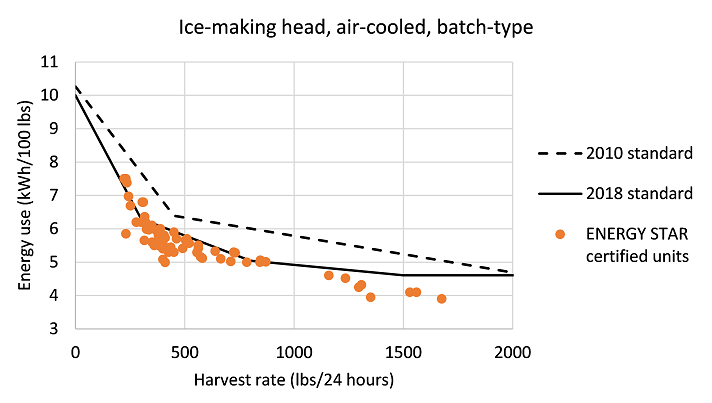
Manufacturers are not just meeting, but beating new efficiency standards for commercial ice makers that take effect on January 28. This is good news for the restaurants, hotels, convenience stores, and other businesses that use ice makers since more-efficient equipment means lower utility bills.
At a fast food restaurant, ice makers typically sit on top of the fountain drink dispensers. Ice makers can produce either hard “cube” ice or softer “flake” or “nugget” ice. Flake ice is often used to display fish, while nugget ice—also known as “chewable” ice—is becoming popular for serving drinks in food-service establishments.
Prior to the new standards taking effect, national efficiency standards applied only to machines that make cube ice. The new 2018 standards, which were published by DOE in 2015, apply to all types of ice makers. Further, while the previous standards covered ice makers that produce between 50 and 2,500 pounds of ice per day, the new standards extend to machines with capacities up to 4,000 pounds.
The 2018 standards improve on initial national standards that Congress enacted as part of the Energy Policy Act of 2005 and which were based on earlier state standards adopted by California and a handful of other states. The previous national standards took effect in 2010. The new 2018 standards represent savings of 10-25% for most ice machines compared to the 2010 standards.
The graph below shows the 2010 and 2018 standards for the most common type of ice makers, which are referred to as “ice-making heads” and which produce cube-type ice. (Ice-making heads are typically mounted on a separate storage bin or other equipment that uses ice, while “self-contained” ice makers have an integral storage bin.) The graph also shows the ice makers that were certified as of January 2018 as meeting the Version 2.0 ENERGY STAR specification (which took effect in 2013). The most-efficient models use 18% less energy than ice makers just meeting the 2018 standard.

Source: ENERGY STAR Product Finder. Accessed January 17, 2018.
In recognition of the availability of ice makers that beat the new DOE standards, a new ENERGY STAR specification (Version 3.0) will take effect concurrently with the minimum standards to continue to recognize the most-efficient models in the market. According to EPA, the new ENERGY STAR specification will recognize ice makers that deliver savings of 8-20% depending on size and type, which translates to $100 to $850 in utility bill savings over the lifetime of an ice machine.
Innovation by manufacturers to not just meet, but beat efficiency standards is providing customers with a wide range of efficient ice makers that will save energy and reduce utility bills while continuing to help keep drinks cold.





